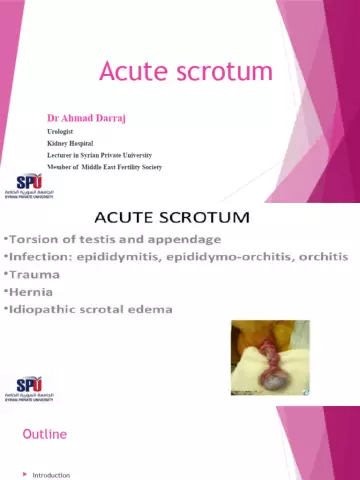- Author Curtis Blomfield [email protected].
- Public 2023-12-16 20:44.
- Last modified 2025-01-23 17:01.
Let's consider such an organ as the scrotum: what is the scrotum, what is its structure, function, type and problems that may be associated with it.
Building and location
The scrotum is a protrusion of the anterior abdominal wall in male mammals. Usually inside it has two chambers, each of which contains a testicle, an appendage and a spermatic cord. This is the basic structure of the scrotum.

This organ is located between the anus and the penis. It is believed that the placement of the testicles not inside the body of men, but in the scrotum is required due to the need to maintain a constant temperature, which is lower than body temperature (34.4 degrees). Thanks to the muscles, this temperature is kept almost constant. That is, the testicles either approach (pull up) to the body in the cold, then move away in the heat.
What are the diseases
So we know what the scrotum is (what it is and where it is). Let's move on to the study of the main diseases associated with this organ.
1. Inflammation of the scrotum (may be caused by infections or physical impact). In difficult cases, the patient is hospitalized, in simpletreated at home. In any case, treatment is mandatory, and the consequences can be unpleasant. The main symptoms of inflammation of the scrotum are pain, itching, any redness or increase in volume, as well as spotting along with semen. If pain in the testicles continues for more than a day, you should immediately consult a doctor.

2. Cancer of the scrotum. Most often it is skin cancer in this area. There are also rarer types of cancer of each of the constituents of this organ. How to understand that the source of cancer is the scrotum? What is scrotum skin cancer? The patient can obtain these data only after passing a fairly serious examination. The reason for its passage is the appearance of any neoplasms in the area of this organ, even if they do not bring discomfort.
3. Undescended testicle. Congenital disease of the scrotum. A situation where one or both testicles remain inside a person and do not descend. Most often, the testicles fall into place in children a few months before birth or within a few months after. If this does not happen, then surgical intervention is necessary.
Which doctors should I contact?
So, having learned that it is the scrotum that hurts, that such a phenomenon must be treated, patients are wondering which doctor to run to? You can, of course, go to a therapist who will independently redirect you to the right specialist. But spending time on this completely unnecessary link in the chain is not at all necessary. First of all, you should contact an andrologist orurologist. These are narrow specialists in this field who know what the scrotum of a he althy person looks like and all the external signs of various pathologies.

These specialists can send you, for example, to a surgeon (if we are talking about a hernia of the scrotum and other problems of this kind), or to an oncologist (if a malignant tumor is suspected). In the office of an andrologist or urologist, you can also take all the necessary tests and get advice on the prevention of various diseases in this area.
Functions
As already mentioned, the main function of the scrotum is to maintain the optimal temperature for spermatogenesis. To this function, we will add another protective one. The testicles in the scrotum are located relative to each other in such a way that allows them to be protected from being pressed against each other. The correct functioning of this organ and its components is the key not only to a long and he althy life, but also to procreation. Problems associated with diseases of the scrotum can lead to infertility and impotence.
Prevention
There are a number of general rules for the prevention of diseases of the scrotum. In order to avoid inflammatory processes associated with mechanical damage, caution and thrift in relation to this organ is necessary. To prevent viral and bacterial diseases, you need to follow the rules of hygiene and accuracy in sexual intercourse.

Every man should think about his men's he alth before he alth itself speaks about itself. After all, preventing a disease is sometimes much easier than treating it.
Take care of yourself. This will help us raise a new he althy generation.






